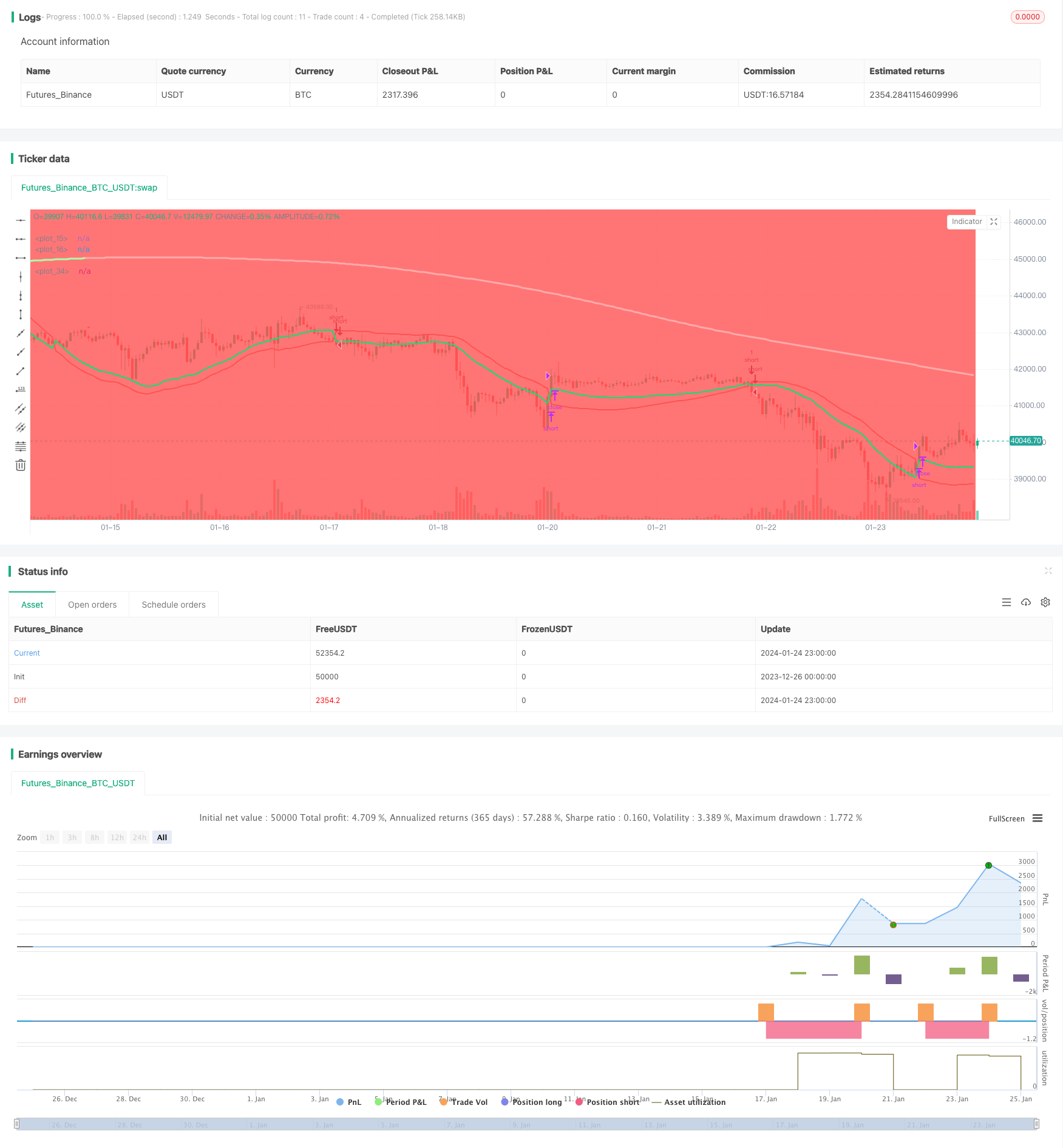
概述
本策略通过结合线性回归指标与双指数移动平均线,实现短线跟踪操作。策略基于价格突破上下轨时建仓做空,在价格重新突破时平仓。同时,该策略还利用双指数移动平均线判断价格趋势,作为建仓的辅助条件。
策略原理
本策略主要通过线性回归指标来判断价格的突破。线性回归指标是根据一定周期内的最高价和最低价,采用线性回归法计算出的上下轨。当价格从上轨下穿或从下轨上穿时,我们认为是一个交易信号。
另外,该策略还引入双指数移动平均线判断中间趋势。双指数移动平均线可以更快响应价格变化。当价格从上轨下穿,如果此时双指数移动平均线已经位于价格上方,表明目前处于下跌趋势,这时我们建立做空仓位。当价格重新突破上轨或突破双指数移动平均线时,我们平掉仓位。
具体来说,策略主要包括以下几个要点:
- 计算线性回归上轨和下轨
- 计算双指数移动平均线
- 当价格从上轨下穿,且双指数移动平均线高于价格时,建立做空仓位
- 当价格重新突破上轨或高于双指数移动平均线时,平掉做空仓位
优势分析
相比传统移动平均线等指标,该策略具有以下几点优势:
- 线性回归指标可以更快速捕捉价格变化,作为建仓信号更有效
- 双指数移动平均线判断趋势更加敏感,可避免假突破
- 结合双重指标和条件,可以过滤掉一些噪音,使交易更加稳定
风险分析
该策略也存在一些风险需要注意:
- 线性回归指标对参数敏感,不同周期可能产生不同结果
- 双指数移动平均线可能出现背离,判断失误
- 突破类策略可能增加滑点风险
- 震荡行情中可能出现频繁开平仓
对于以上风险,我们可以通过参数优化、严格止损、适当放宽突破幅度等方法来解决。
优化方向
该策略还可从以下几个方面进行优化:
- 对线性回归周期和双指数移动平均线周期进行优化,找到最佳参数组合
- 加入价格震荡幅度判断,避免价格微量突破造成错误信号
- 增加成交量等辅助条件,确保突破有效性
- 设置止损层次缩小单笔损失
- 针对特定品种调整参数
总结
本策略综合运用线性回归指标和双指数移动平均线,在理论和实践上均有一定优势。通过不断优化调整,可以进一步提高稳定性和策略效果。该策略适合短线操作,可为量化交易者带来较好的alpha。
策略源码
/*backtest
start: 2023-12-26 00:00:00
end: 2024-01-25 00:00:00
period: 1h
basePeriod: 15m
exchanges: [{"eid":"Futures_Binance","currency":"BTC_USDT"}]
*/
//@version=4
strategy('LR&SSL_Short', overlay=true)
startP = timestamp(input(2017, "Start Year"), input(12, "Month"), input(17, "Day"), 0, 0)
end = timestamp(9999,1,1,0,0)
_testPeriod() => true
len = input(title="Period", defval=89)
smaHigh = linreg(high, len, 0)
smaLow = linreg(low, len, -1)
Hlv = 0.0
Hlv := close > smaHigh ? 1 : close < smaLow ? -1 : Hlv[1]
sslDown = Hlv < 0 ? smaHigh : smaLow
sslUp = Hlv < 0 ? smaLow : smaHigh
plot(sslDown, linewidth=2, color=color.red)
plot(sslUp, linewidth=2, color=color.lime)
length = input(200, title="DEMA")
d1 = ema(close, length)
d2 = 2 * d1 - ema(d1, length)
trendColour = d2 > d1 ? #AAFFAA : #FFAAAA
dema=sma(d2,length)
turnGreen = d2 > d1 and d2[1] <= d1[1]
turnRed = d2 <= d1 and d2[1] > d1[1]
up =turnGreen
down=turnRed
plotshape(down, title="down", style=shape.triangledown,location=location.abovebar, color=color.red, transp=0, size=size.small)
plotshape(up, title="up", style=shape.triangleup,location=location.belowbar, color=color.green, transp=0, size=size.small)
plot(dema, color = trendColour,linewidth=3 ,transp = 0)
bgcolor(close > dema ? color.green : color.red)
strategy.entry("short", strategy.short, when= crossunder(sslUp, sslDown) and dema > close and _testPeriod())
strategy.close("short", when = crossover(sslUp, sslDown) or crossover(close, dema))